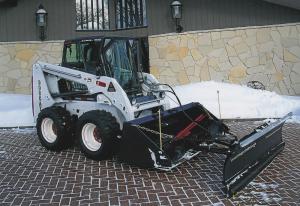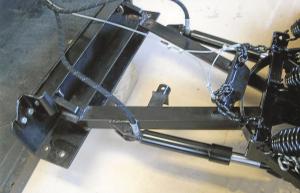2011 - Volume #35, Issue #1, Page #35
[ Sample Stories From This Issue | List of All Stories In This Issue | Print this story
| Read this issue]
Skid Steer Snowplow Mounts On Bucket
 |
 |
"I remove snow for 20 customers and I can squeegee a brick driveway without leaving a scratch," he says. "Putting the plow out ahead of the bucket lets me use the bucket to carry shovels, salt and even a snowblower."
Schultz prefers the versatility and maneuverability of the skid steer to a pickup-mounted snowplow. But he wanted a blade that would oscillate to follow the ground surface.
"Most skid steer attachments are too close to the machine and too rigid. By mounting the snowplow to the bucket, I can push snow away from the drive and out onto the lawn without the wheels leaving the drive. It also lets me raise the snowplow 10 ft. in the air to push snow into piles."
Schultz started with the standard 6-ft. wide pickup style snowplow. Using 3/8-in. thick, 36-in. long, 12-in. wide steel plate, he fabricated a 6 by 6-in. angle iron mounting plate. He drilled 4 holes on one face to match the 4 universal holes in the loader bucket edge and bolted that face flat. A second angle iron, also of 3/8-in. steel, but 24 in. long and with 3 by 3-in. sides was fabricated with tabs to match the snowplow's A-frame mounting pins. It mounts to the snowplow bracket with its horizontal face up.
To mount the two angle irons together and provide the desired oscillation for the snowplow, Schultz drilled a hole top-center of the 6 by 6-in. angle iron and centered on the vertical face of the 3 by 3-in. angle iron. When bolted together, the horizontal face of the 3 by 3 is flush with the top of the vertical face of the 6 by 6.
Schultz used a #8 hardness, 1-in. dia. bolt to fasten the two angle irons together. Double nuts on the bolt are tightened only enough to allow the angle irons to swivel against each other, giving them up to 2 in. oscillation. At the ends of the 6-ft. snowplow, that translates into considerably more lift.
To provide float, Schultz hooked lengths of chain from each corner of the bucket to the end of the snowplow frame closest to the plow. They allow the plow to flex upward over a rise in the surface. However, they prevent it from dropping into a trench.
Schultz realized that if one end of the plow struck a curb or buried object, the torque might be enough to rip out even a 1-in. bolt. To prevent that, he fabricated two brackets that he mounted to the vertical face of the 6 by 6 at the ends of the oscillating 3 by 3 angle iron.
"The brackets have tabs that extend over the end of the 3 by 3 angle iron," explains Schultz. "They serve as stops to hold it in place if need be."
To provide more flexibility and squeegee action, Schultz bolted a 4-in. wide strip of heavy-duty conveyer belt to the bottom edge of the snowplow blade. This added edge also allows him to keep the bucket bottom about 4 in. above the surface to be cleared.
"The belting won't tear up grass or lawn; it just passes over the top of it," says Schultz. "If I hit packed snow, I just tip the bucket so the edge points down, and I chisel the heavy stuff loose."
Schultz also covered the face of the snowplow with a layer of urethane plastic used in building stock cars. "It's tough to bend, and I needed to use strips of angle iron to retain it against the bucket," he says. "But even wet snow just slides off it."
Contact: FARM SHOW Followup, Gary A. Schultz, 2436 Belmont Ct., Janesville, Wis. 53548 (ph 608 752-7318).

Click here to download page story appeared in.

Click here to read entire issue
To read the rest of this story, download this issue below or click here to register with your account number.




